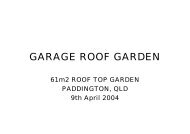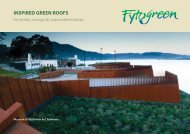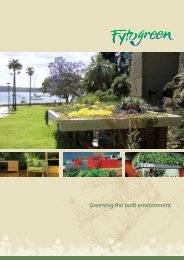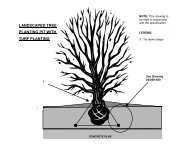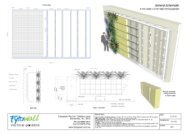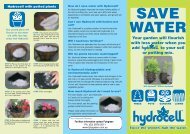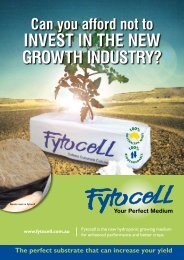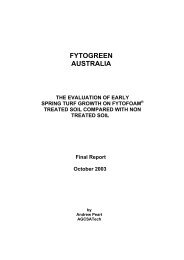THE GREEN-ROOF - Fytogreen
THE GREEN-ROOF - Fytogreen
THE GREEN-ROOF - Fytogreen
You also want an ePaper? Increase the reach of your titles
YUMPU automatically turns print PDFs into web optimized ePapers that Google loves.
Australian Horticulture<br />
November, 2007<br />
Page: 12<br />
Section: General News<br />
Region: National Circulation: 3,594<br />
Type: Magazines Trade<br />
Size: 1,170.40 sq.cms.<br />
Published: Monthly<br />
Brief: NESTPR<br />
Page 2 of 4<br />
profile can hold enough water for up to one month's watering, yet saturated<br />
it is still lighter than the dry weight of traditional podium soil profiles.<br />
"It is water-efficient, cutting maintenance costs, and requires 50% less<br />
water than traditional podium soil but has increased root-growing volume<br />
in a thinner profile, allowing plants to flourish."<br />
Tyler says Hydrocell is low in organics to prevent slumping, needs no<br />
top-up, is open and free-draining, and does not stain paving.<br />
"It has a stable, long-life expectancy, with examples showing a 20-<br />
year-plus life span," he says.<br />
Hydrocell is suitable for use in all types of roof gardens. Extensive gardens<br />
with shallow profiles of 80 millimetres to 100mm require no maintenance<br />
and are ideal in inaccessible areas, planted with sedums and<br />
other succulents and grasses.<br />
Semi-extensive gardens with a thin profile of 100-200mm demand little<br />
or no maintenance, do well in areas with limited access and can be<br />
designed to support turf, grasses and groundcovers. Intensive plantings<br />
of 200-1200mm allow a full plant selection and are an excellent option<br />
for recreational spaces.<br />
Tyler suggests lightweight roof gardens include 50%, washed sand,<br />
40% Hydrocell and 10% composted organics (known collectively as<br />
Hydrocell-40 lightweight soil) laid over a solid layer of Hydrocell RG30,<br />
a geotextile membrane, a drainage cell of Fytonop and, finally, a LDPE<br />
sheet. "This is our <strong>Fytogreen</strong> roof-garden profile for intensive types of<br />
gardens," he says.<br />
<strong>Fytogreen</strong> has already created gardens on the roofs of key buildings in<br />
Melbourne such as a residential apartment block in FreshWater Place,<br />
Southbank, designed by architect Laurence Blyton and built by<br />
Multiplex for Australand.<br />
Foaming equipment was craned in to allow dispersion of a 100mm<br />
layer of Hydrocell RG30 as a reservoir layer to water up to the Hydrocell-<br />
40 blend lightweight topsoil blend. With a minimum profile of 400mm,<br />
the garden is now home to tall-fescue turf, deciduous trees and groundcovers.<br />
Created in 2004, the area was extended two years later and is<br />
now used recreationally by residents.<br />
Hydrocell-40 is also recommended for use in planter boxes and patio<br />
boxes, again with a 100mm-thick layer of Hydrocell RG30 as as a reservoir<br />
layer that also filters and protects the geotextile and drain layers.<br />
Going up<br />
But the product options do not end there. <strong>Fytogreen</strong>'s range includes<br />
Fytofoam, Fytocell, Fytowall and Modular Turf. Fytofoam is designed<br />
for broadacre application, while Fytocell is a specialist hard foam for<br />
hydroponic systems.<br />
Modular Turf is is turf module for use in vertical situations such as<br />
staircases, and on grass-topped bollards. Tyler says more than 30 turf<br />
varieties have been tested successfully to date.<br />
Fytowall is perhaps the most spectacular of all, at least to the naked<br />
eye. It is a series of vertical growing panels designed to support vegetative<br />
walls either indoors or out.<br />
<strong>Fytogreen</strong> was first unveiled at the Landscape Australia Expo in<br />
Melbourne in August, where it attracted much industry attention.<br />
So far, more than 100 plant species have been evaluated on a research<br />
wall, with watering, feeding and growth rates all measured. Developed<br />
in Australia, the Fytowall system consists of 40mm-by-90mm zincalume<br />
vertical battens and a box edge to which a frame or facade is attached.<br />
Each interchangeable panel - measuring 100 centimetres by 50cm<br />
high by 14cm deep - covers 5000 square centimetres, weighing up to 44<br />
kilograms fully saturated with plants (or 88kg per square metre of surface<br />
area).<br />
Copyright Agency Limited (CAL) licensed copy<br />
Ref: 31467137




